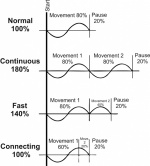Knowledge of Taekwondo for 4th KUP
Knowledge /
Main Menu
Knowledge of Taekwondo for 4th KUP
Exam 4th Kup
Document containing source information
Sine Wave
What makes Taekwon-do unique is the sine wave motion to generate maximum power according to the theory of force.
It is used in almost every movement. Natural wave motion is simple.
During lessons and seminars Taekwon-Do practitioners learn to apply the "sine wave" in their techniques.
What we do in fact, in the execution of the wave motion in Taekwondo techniques, is moving the center of mass of the body. That means that if we were to draw the outlining of the hip motion, it would look like a sine wave (click on figures to enlarge).
There are some advantages to use a wave movement that are related to the training of secrets of taekwon-do. To move the center of our mass in the movement of a wave, our legs must be bent while the body is in motion. To keep the legs and arms bent over a movement, we need to be relaxed. By relaxing the body, extra speed is given to a technique because the various parts of the body do not work against each other, as that is the case with voltage. Force equals mass times velocity squared, so a small gain in speed and a big gain in strength.
When we perform a wave motion, we also need to make use of a "knee suspension" (knee spring) on the correct manner. By bending our knees as we move, the body is moved up and down forward by the knee bend. While the body moves, our center of mass moves on a curve, which is a form of acceleration.
Finally, when wave motion is applied, it contributes to the use of gravity to our advantage and can assure that the acceleration increases at the moment of impact.
To apply the wave correctly in Taekwon-Do, we need to adjust the shape of the wave to achieve maximum power. In other words, the sine wave is not a uniform curve as shown in Figure 1. The wave motion is adapted so that the body "falls" at the time that it has reached the half of the trajectory of a technique and comes up to maximum height at about three quarters of the route. Then, the body comes down quickly at the end of the movement. The rapid "fall" at the end of the technique helps our mass to accelerate into the target, using the force of gravity.
Back to top of page - Back to Welcome Page
Five different tempos
The base of the wave motion is down-up-down, this means there is always a downward movement, followed by an upward movement and ending with a downward movement. However, there are variations to the wave motion which are dependent on the rate of the movement and the combination of the used techniques. There are five different tempos :
- Normal motion
- In SAJU JIRUGI, SAJU MAKGI AND CHON-JI TUL, Taekwondo students learn the normal pace of connected movements. That is the first "motion": normal motion (normal speed). Movements performed in a normal pace, with a wave motion in one breath.
- Continuous motion
- DAN-GUN teaches Taekwondo students the second motion: continuous motion (sequential pace). Two movements are performed sequentially, twice with wave motion in a single breath.
- Fast motion
- Do-San brings in a new motion : fast motion (fast pace). Two motions are carried out in quick succession, twice with wave motion in two breaths.
- Connecting motion
- Normal motion
In YUL-GOK brings a new motion: connecting motion (attached pace). Two movements performed connected, with one wave motion in one breath.
- Slow motion
- JOONG-GUN completes the fifth and final motion: slow motion (slow pace). In slow motion, the move is slow but, in relation to the theory of power there is acceleration at the end of the movement. There is one (slow) movement, one wave at a (delayed) breathing. Slow motion performances of techniques allow more body control and exercises the balance of the student.
- Slow motion
Determine the five different tempos of the wave motion, of which three variants are:
- Full wave
- 2/3 wave
- 1/3 wave
There is a full wave motion (down-up-down) ONLY in normal motion, continuous motion and slow motion.
In fast motion, there is a 2/3 wave motion, since there is only an up and a downward motion in the movement. An example can be found in DO-SAN TUL: the two punches that follow the AHPCHA-BUSUGI (movements 15 & 16 and 19 & 20)
In the connecting motion, there is a 1/3 wave motion, since there is only a downward movement taking place. An example can be found in YUL-GOK TUL: the impact that follows the second hooking block (movements 16 & 17 and 19 & 20).

